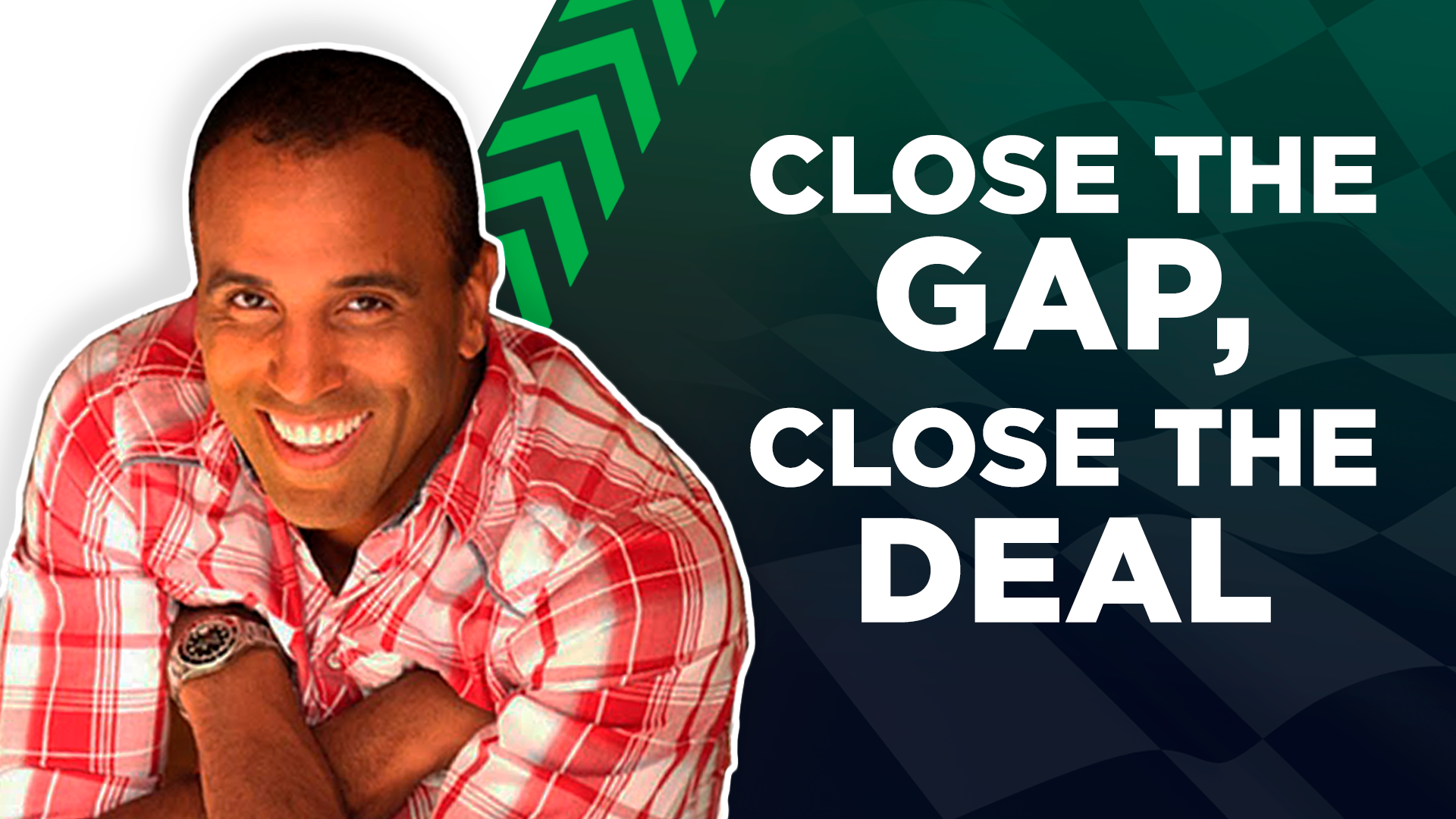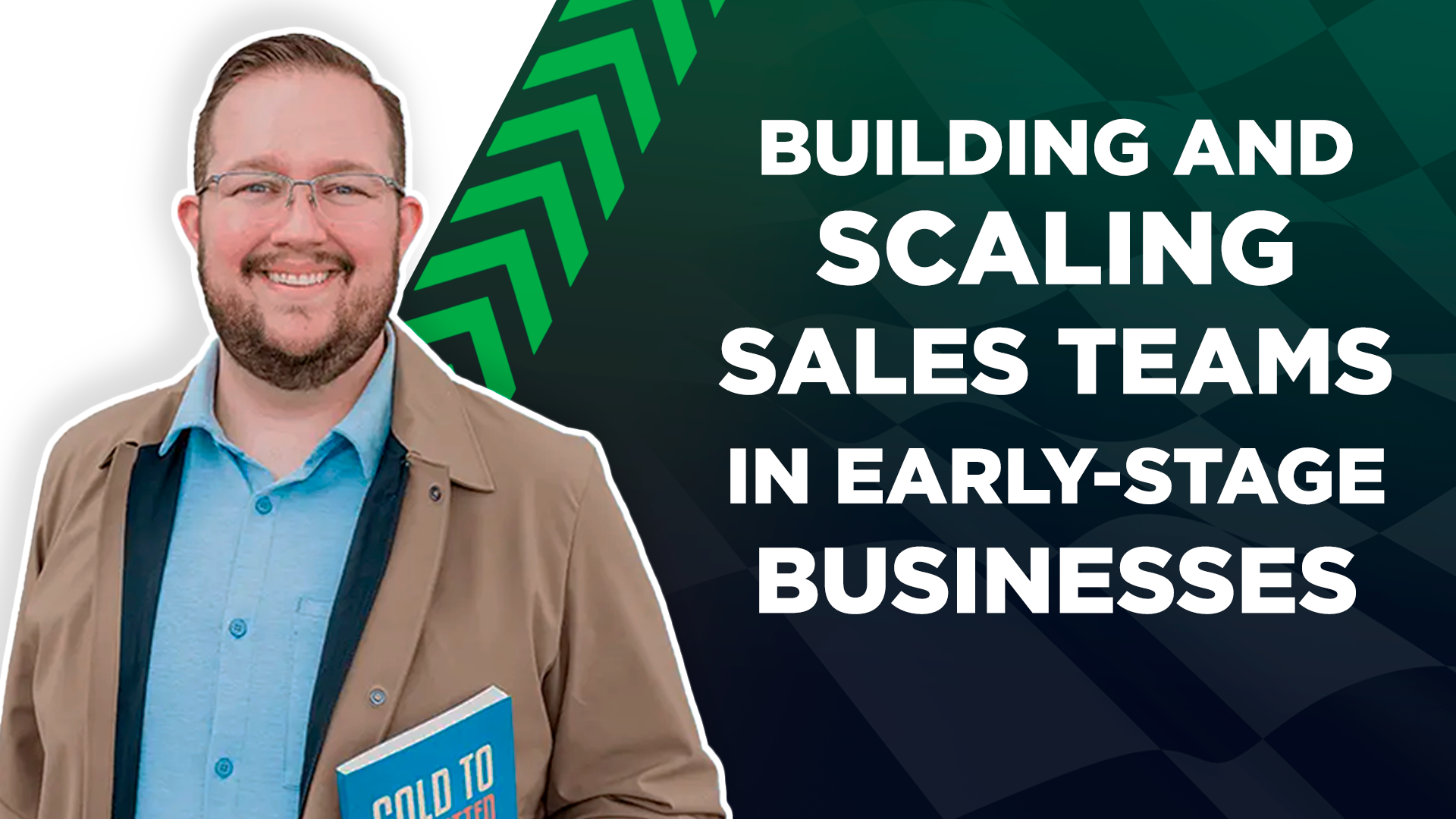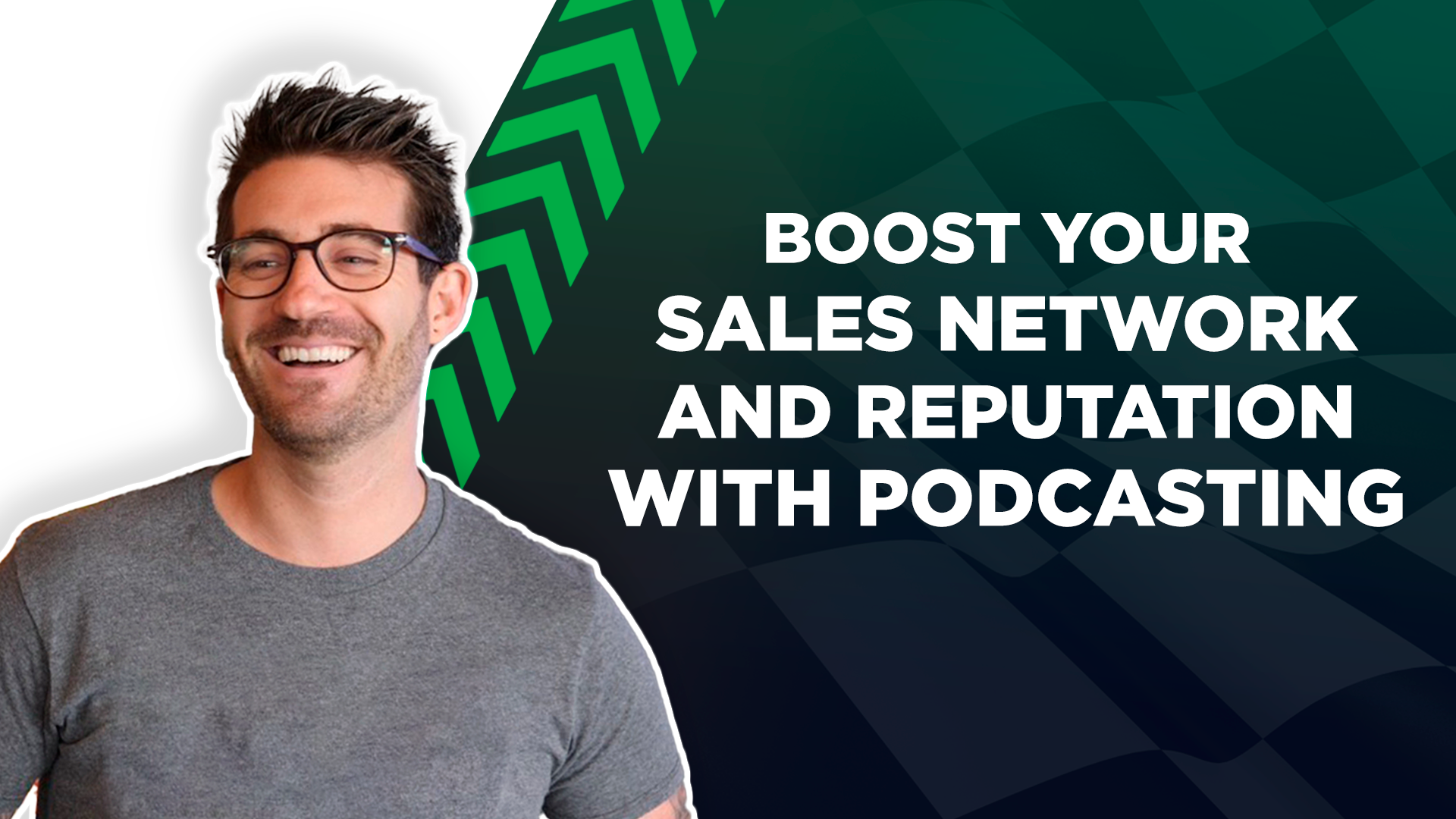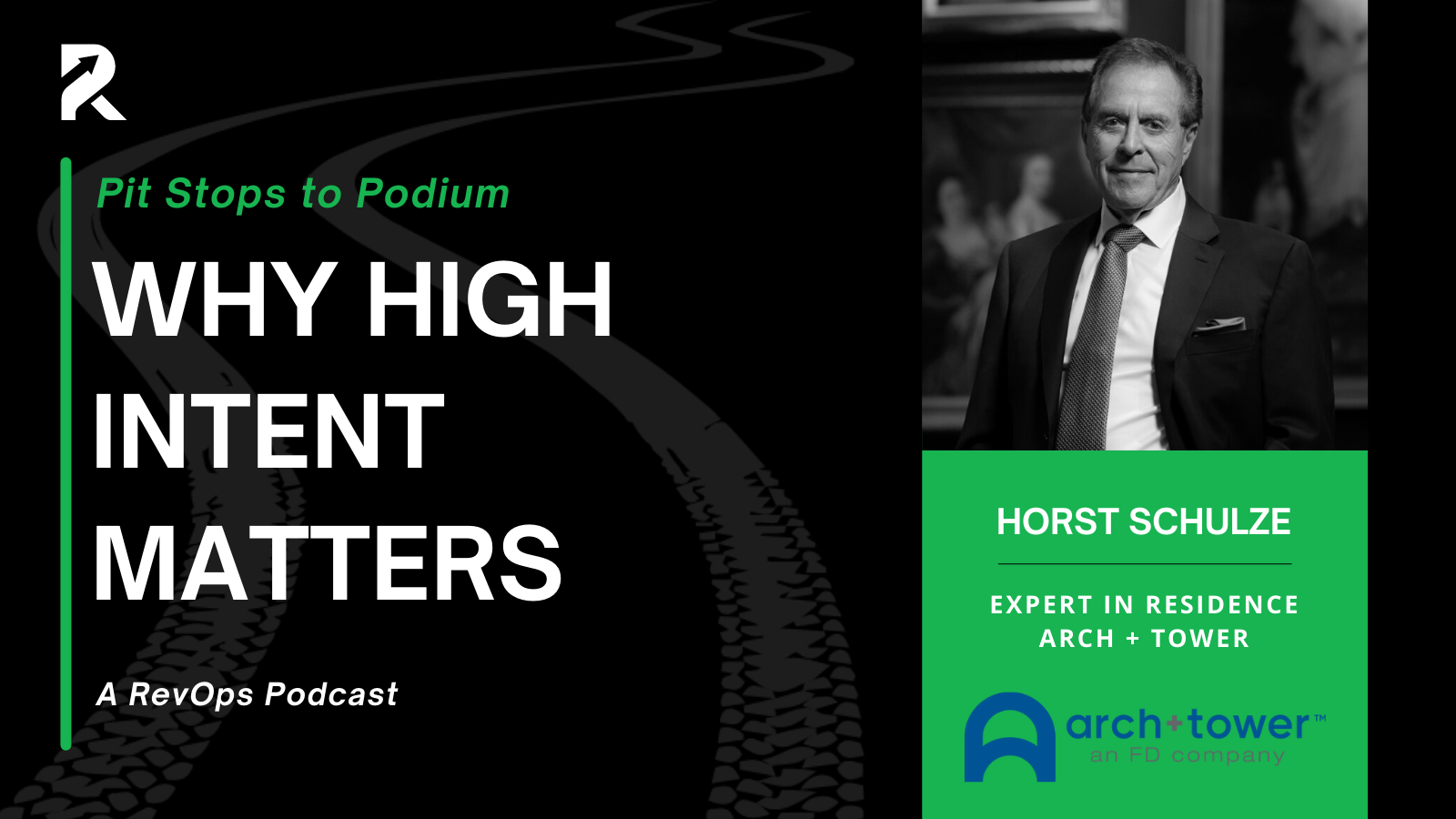Table of Contents
Close the Gap, Close the Deal
In episode 75 of Pit Stops to Podium, we sit down with Keenan, the CEO & President at A Sales Growth Company. With 37 years of sales experience and the author of the best-selling book "Gap Selling," Keenan brings immense knowledge to our discussion. Recognized as a top influencer in social sales by Forbes, his expertise has been featured in publications like Fast Company, Harvard Business Review, Sloan MIT, and Inc.
In this episode, Keenan will share valuable insights on diagnosing and understanding "The Gap" within the sales process, along with the importance of opportunity management and how to transition from a product-centric selling approach to a problem-centric selling approach.
If you’re ready to learn from one of the best, then buckle up and hold on!
Pitstop Highlights
What is the Gap?
Traditional sales is built around the transaction, whereas Gap selling is based around the concept of how to assist the prospect in change management. Change management starts with the assessment of the current state and then looks at what a change for an organization or individual would look like. The seller is the hero in the transaction because they have helped the buyer make the right choice.
TL;DR...Future state minus the current state is the gap.
"Your job as a salesperson is to go in and start to try to understand why does that buyer need to think they need to change"
Effective Tools or Questions to Discover the Gap
You can't help someone if you don't understand their problem. Five elements you need to know:
- The physical and literal
- What's the problem?
- What's the impact?
- What is the root cause?
- Future state
"Once I have the root causes I know why this problem exists"
Why Sales Reps Focus On The Product Instead of the Problem
Two reasons:
- They don't know how and they haven't been taught
- They are in sell mode
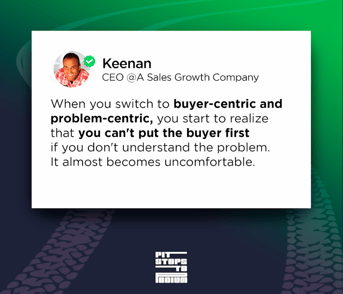
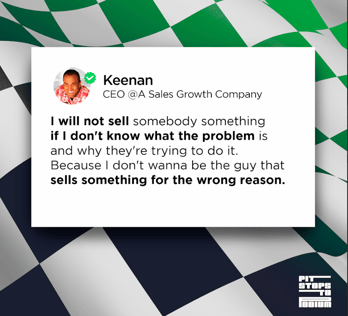
Coaching Reps for Urgent Deal Closure Based on Customer Goals
The first step to managing the opportunity is management needs to act as the auditor of whether or not the gap is big enough. Most of the time, salespeople won't gather enough information the first time around.
The second step is making sure the gap is calculated and they're helping the buyer set up their way of moving it through the buying process and decision criteria.
"We use the client's words to drive the sale"
Connect with Keenan
Website: https://salesgrowth.com/
LinkedIn: https://www.linkedin.com/in/jimkeenan/
Full Transcript
Brendan: Hey everyone, welcome to Pit Stops at Podium, the RevPartners podcast where we talk to execs who have competed and won in taking their companies from high growth to high scale. My name is Brendan Tolleson, I serve as the co-founder and CEO of RevPartners, and I'm delighted to have with me today Keenan for this episode of Pit Stops to Podium. Welcome Keenan.
Keenan: What's up, my man? You know what's so funny is I talk fast, but you're a good Southerner, but when you said pit stop to podium, I must've heard five times, pissed off the podium. Like literally like, I literally was like, I kinda like where he's going here, man. Like pissed off and like, I wanna make a change. And then I looked up and like, oh, it's pit stops to podium, not pissed off from the podium. That was good.
Brendan: Well, maybe I got a little edge to me, you know, we had a little our little prep and I got called out for asking you about your last name. So I'll take it. So, Keenan, we're pumped to have you here.
Keenan: Thank you, bro. Thank you.
Brendan: Well, Keenan, for those that don't know you, I'd love for them just to hear a little bit more about who you are and what you do and how you got to where you are today.
Keenan: That's a long story, so I'll try to make it short. Look, I'm the author and CEO of Gap Selling. I am the CEO of a sales growth company and Noted Analytics. Sales growth company is a sales consulting and training firm and Noted Analytics is a deal management SaaS platform that helps improve win rates and average sales price. Basically, the short, short story is I've been in sales my whole life, started blogging in 2009 as a way to help. move my career along because my career was so far ahead of my quote unquote years of experience that I found it difficult to compete because I'd be in my early 30s or mid 30s and I'd be competing with people in their 40s and 50s based on the size of the job I had. So I said, screw resume because LinkedIn wasn't that big yet. And I said, I'll blog about what I know about sales and marketing, growing sales teams and accelerating revenue, blah, blah, blah. Maybe a thousand or two people will follow me. And if I ever need a job, I'll just say, hey, I'm looking for a job. and those people will know me, I'll have shown them what I do. And that should accelerate the job search. Well, after two years of that blogging, 700 and what is it, 755 days straight or whatever it is, 772 days straight, people started reaching out, asking me to do work for them and thus Sales Growth Company was born. So there you go.
Brendan: Well, that's great. 700, you said 772 days straight.
Keenan: Yeah, so you got two years of blogging every single day. If you went back and did an audit, I may have missed nine, 10, 12 or something, but basically, yes, every single day for two years.
Brendan: I think we can round up. That's pretty impressive. Well, Keenan, we'll get into a little bit of some of those topics that you preach on, whether it's in your book or with your clients around gap selling. But before we get into that, we do have a tradition here at pit stops to podium, and that's to get to know our guests outside of work. So what are some fun facts that our audience should know about you? What do you do in your free time, family, friends, hobbies, et cetera?
Keenan: I'm a huge skier. Everybody who knows me and follows me knows I'm a huge skier, particularly mogul skiing is my passion. I have, and I'm a dad girl. I got three daughters, all competitive skiers. Two are competitive mogul skiers and one is a competitive park and pipe skier. They go to a full-time ski school called Vail Ski and Snowboard Academy. They're all very good. However, my youngest is one of the, she's only 12 and she is ranked second for U15, which means girls older than her. She's ranked first in her age group. And for you 17, I believe she's ranked ninth in the country for all ages at 12 years old, including our Olympic team. So she's on a good path.
Brendan: How competitive are they with each other?
Keenan: Not very, that blows my mind. That was a fantastic question. They aren't very competitive with each other. Okay, sports wise, this is the weirdest thing. Talk time wise, cause they're all fairly outgoing in their own different ways, there's really no introverts. My middle is an analytical, so she can be perceived as an introvert, but they're all fairly extroverts. And the only thing they compete on is talk time. So one of them be talking. and the other one interrupt him like, hey, I was just talking, I wasn't finished. They start arguing over who gets to talk. That's pretty much the most competitive they are with themselves. With everybody else in the world, they're super competitive.
Brendan: Who gets to talk the most at the dinner table? Between the kids and you.
Keenan: Pretty even. Yeah, no, seriously, it's pretty even.
Brendan: And did you pick it up from your kids or did you instill the desire to do mobile skiing?
Keenan: No, I fell in love with mogul skiing when I was in my early twenties, self-taught and did it more and more because skiing got boring after a while when you just do the flats. It's like, this is just getting boring. And so, but mogul skiing is hard. Like, and when I grew up, that's what the best skiers did. There was no park and pipe yet. Like you went on the mountain and you saw these dudes just ripping a zipper line. Whoa, I want to be like him or her. So I did it. Then when my kids were young, they followed me around and then they started competing and all of them hated chasing sticks. They hated Alpine skiing. It's boring, it's stupid, it's icy, it's dumb. So they would follow me around in the moguls and then my oldest wanted to do park and pipe. The other two chose moguls and it just kind of went the way it went.
Brendan: That's really cool. Well, hey, thanks for sharing a little bit about what you do outside of work. It's always fun to hear from our guests. We're human beings, not human doers at the end of the day. So it's fun to see the balanced lifestyle, or what we strive to be a balanced lifestyle. Let's, let's move into the big idea. I talked a little bit about gap selling and a lot of the themes that we are going to discuss are central to that. And so close the gap, close the deal. And so I'd love for our audience who may not have read that book, just What do you mean by the gap? Let's start there, because I think that'll give the context for the conversation.
Keenan: So in traditional sales methodologies and traditional sales trainings and all that stuff we've had for the last 50, 60 years, they're all built around the concept of the transaction. How do I influence the transaction to win? So if I'm talking about, let's just say, it's budget, need, budget authority, need, timing, all of that is based on how do I drive the transaction to my favor? Gap selling is based around the concept of how do I assist the prospect in change management? And that has been the missing link, in my opinion, for 60 years. Sales is not about a transaction to the buyer. It is to you, but not to the buyer. To the buyer, it's about change management. Something is not going well in my organization today. I perceive that, I sense that. I think it's big enough to change. Let me reach out to a sales rep and find out what my alternatives are and if it's worth changing. That context, that scenario right there is what sales is all about. So if you're going to be a change manager instead of a transaction, a tender transaction, you have to start with, well, why should somebody change? If it's about change management, why should I change? So your job as a salesperson is to go in and start to try to understand why does that buyer need to think they need to change? So in Gap Selling, we call that the assessment of the current state. Where are they today? What is going on? Why do they think that they change? What are the issues they're having? How is it affecting the business? What happens if they don't do it? You uncover all of that and that's called the current state. Then you say, great, well, where would you like to go? Why do you have to go there? What happens if you don't? What are the objectives? How are you gonna measure the outcomes? What are the desired outcomes, right? What are the opportunities for you? And once you do that, believe it or not, a gap is formed. And that gap is the space of where they are today and what they can't do and what's negatively affecting them to. if they could change what they could change to and how that would change the world and what the new outcomes would be. So the current state of not changing, so what I say the future state minus the current state is the gap. And that's what they buy by the way, they buy the gap.
Brendan: Yeah, and I think there's also like, they believe that your product or service will close that gap.
Keenan: Yes.
Brendan: And so, yeah, I love that kind of mentality. It's also a reminder that the customer is the hero, not you. And while you may want it as a transaction, it's really what is in the best interest of the customer and helping them. You may know they have it, that they need to buy it, but it's helping them know that they need to buy it to drive the urgency to actually take an action. Because to your point, it is change management. Let's...
Keenan: But what's interesting is I would challenge you a little. If done right, the seller is the superhero. Because what they did is they brought the problem to light. They allowed the buyer a better vision of the world they were in. They allowed the buyer to make a better decision. And that decision could be, we didn't need to make this massive investment. We almost spent X and we didn't need to. Thank you, salesperson. Or they were like, oh, we almost bought. Why? Because we thought that's what we needed and thank you so much now that we see this, it's the same amount, but we're buying this, thank you. So I would actually argue you are the superhero, not because of the transaction, but because of your value in helping them make the right choice and make the appropriate change for them. That's why it's change management.
Brendan: I agree with the end state. I think there's a guy named Donald Miller, I don't know if you ever read his material, but he talks like this, called StoryBrand. And it's exactly what you just said. He uses the word the guide. And so you're that trusted advisor that's giving them clarity around what decisions they should make. And so I think superhero works well too.
Brendan: So one of the things you had talked about a little bit was the assessment, right? So kind of depending on who we're talking to, that could be that discovery call, but it's really helping to diagnose future state, current state to inform the gap. What are some effective tools or questions that you teach on that our audience should be aware of? How do I really create that urgency understanding what that gap really looks like? Cause it seems like discovery is where that takes place. Is that accurate?
Keenan: 100%, 100%, because you, no, I haven't read his book out of fairness, but in the quick blurb you gave, I agree with him, story and being the hero and showing them how you can help them. But what everybody's, excuse me, what everybody seems to miss to me is you can't help somebody if you don't understand what is going on, right? And go back and look at almost every training and how much effort do they put into truly, truly understanding what's going on. Not nearly enough. So think about all the times you've ever gone into any place in someone said, oh, can I help you? Or they started to help you. And the minute you feel like they don't understand where you are, that they don't understand your problem, they don't understand what you're trying to accomplish or whatever, you're like out, I'm out. But in those rare times that that person makes you feel like, oh, they get it, they're your best friend. Like I always make joke about Home Depot. Some people say, what can I get? You need a hammer, hammers are over here. They start talking about stuff you don't want and you leave them alone. The one guy says, what are you trying to do? And you're like, I'm trying to build a dollhouse for my daughter. He's like, let me guess, you're in here because that hammy you use isn't working. Well, let me, and then next thing you know, you don't want this guy to leave your side because you believe, right? Yeah, yeah, right, he's like, no, wait, you know something? Wait, could I be doing this better? Am I wasting time? Am I screwing this up? He's your best friend, right? Like that, that is how it should happen. So the answer to your question is there is no script. I could not write down the questions for you, but what I do say is listen, five elements you need to know to understand their current state. First, the physical and literal, right? How many dollhouse, how many daughters do you have? Is it one dollhouse? Why are you building the dollhouse? Is it a Victorian dollhouse? Is it one that's already prefab you're trying to put together? You know what I'm saying? Have you ever done this before? Do you already have the materials? It's all just physical. I wanna understand the context. When's your daughter's birthday or your son's birthday? Let's just play 2023, right? Do they have a dollhouse already? Like I wanna just understand the context, right? Then I wanna understand the problem. Okay, so now I know what you're trying to do. I understand the context. What's the problem? What are you struggling with? Have you broken some of the walls? You have a problem with the fine mill work in it? Is it taking longer than you would like? Like what's the problem? Right, so then I understand what the problem is. Then it's okay, what's the impact? If this problem persists, what's the impact? In the dollhouse, it's probably, I'm gonna miss my daughter's birthday, which is horrible because it's her eighth, I guess, or 10th, or I don't know. Especially, I don't want to miss the birthday. That's the impact. I'd be devastated if I can't give my kid her birthday present on that day. Or it could be devastated that I'll give it to her, but it won't stay together, see how I did that? Problem, impact, right? Then I want to know, okay, what is the root cause? Why are you concerned it's not going to be stable? What, like, what is the root causes of those things? You might be able to- There's big hammer, I can't get into little spaces, or I'm using this right now to file the mill work, but it taking me two hours to do one staircase, and at this rate it won't be done until Christmas. And then, oh, and then once I have the root causes, I'm like I know why this problem exists. And that's where the whole future state comes in. So you wanna get this done in time for your daughter, it's her birthday, blah, blah, blah. There's my gap. I know the root causes. Dude, get out of this section. I wanna show you something. And I take you over to another section and show you how the mill work gets done. how it gets glued together, blah, blah, blah, blah, blah.
Brendan: Well, it sounds like what you're, I mean, I love that. And it's almost getting into like transitioning from product centric selling into that whole problem centric selling that a lot of reps fall into that trap. They feel like they have to focus on the product. I'm trying to think of a, I was gonna ask you a question but it's not a good question. It's trying to understand why do they, do you think it's because they're fearful? They don't know how? Like what is the reason why they rest on the product?
Keenan: Two things, fantastic question. One is they don't know how and they haven't been taught. And two, they are in sell mode. Our sales culture has us in 24 hour sell mode. How, watch, remember I said before, how do I drive the transaction? That's all they're thinking about. How do I drive the transaction? Because they're thinking about the me. It's self-centered, A-centric, sales org-centric, so managers are punching in the face with the same thing. It's all sales org me-centric. When you switch to buyer-centric and problem-centric, you start to realize that you can't put the buyer first if you don't understand the problem. It almost becomes uncomfortable. I will not sell somebody something if I don't know what the problem is and why they're trying to do it. Because I don't wanna be the guy that sells something for the wrong reason. I'm not comfortable with that. So my entire brain, my entire brain has been trained to no recommendations until you understand. And that's just not selling from my company. If you would have come to me tomorrow, my man, and you were like, hey Keenan, you know, I was thinking about adding this, buying up this company. And what do you think? And I'm like, I don't have a clue. Like what's going on today? Why do you even think you need to buy a company? Are you not getting enough revenue? Are you having difficulty penetrating accounts? Are you shrinking in revenue? Are your investors telling you not growing fast enough? Do you feel the products you've got are competing? Like I'd want to understand the entire environment. And then I'd say, OK, well, based on this, where do you want to go? And you tell me, I'm like, OK, based on what you've told me, this is what I think and this is what you should do. But that's how my mind works. No one else does that. They rush right to, yeah, you should do that. Sounds good to me.
Brendan: Yep. And then so that gets into the next question I would have is, okay, so we're coaching sales folks to focus more on the problem. So we understand the gap. Now, how do they manage the opportunity from that point forward? And so how do you coach those reps and say, hey, you've got that clarity on where they're looking to go, how big the problem is. Now, here's how you drive urgency to get the deal done.
Keenan: That's a great question. So there's a couple of pieces of this, but the first one is what most people miss is I liken Gap selling a proper problem-centric selling to golf. I wrote the book and I still miss things. And I liken it to golf. This is getting old now, cause it's been about five years, but there was a Masters, now that's coming up this weekend, about three or four years ago, where Tiger, Kepke and Molinari were coming in on the final three holes and they were tied. Kepke and Molinari put it in the drink. These are the best golfers in the world and they put it in the drink. Gap selling is no different. I wrote the book, I will mess up the gap sometimes. I may not ask the right questions. I won't dig deep enough into the problem. So the reason I tell you this is the first step to manage the opportunity is the minute it turns into an opportunity, management needs to act as the guide or the auditor, the auditor of whether or not the gap is big enough. Did you get enough of the problem? Has the problem been defined? Do you understand what happens if they don't move? Why don't they just stick with the status quo? You're missing this information, that information. I don't know this, I don't know that. Why should they buy? That's the first thing because no rep ever gets the first time. So they have to, it's management's job to say, yo, I don't see this as a big enough opportunity. This costs $200,000 a year. I don't see a problem. You said they aren't happy with their current inbound leave. How many are you getting? I don't know. What's the average deal? I don't know. Have they been shrinking or growing? I don't know. Like, so from that perspective, not enough, go back and get it. So that's the first piece. They literally have to act as the auditor for all of those elements I shared with you before. Then the second piece is once they have all of that, they need to work with the rep to make sure that the gap is calculated and they're helping the buyer set up their way of moving it through the buying process and the decision criteria. So the buyer can take what you uncovered for them and move it through the organization. So if anybody says, well, I don't think it's a good idea. You say, well, wait, you said, you're losing a million dollars a month. You said, competition's taking the piece. You said, and these are the root causes. I'm confused why you don't think our solution, which does dah, dah, dah, dah, won't stop that bleeding. It only costs 200,000 a year.
Brendan: I like that. It's interesting. You mentioned, so it's almost, there's a responsibility on the, that manager, almost more so than the AE to ensure that they are getting the support, not even the support, the direction of how to progress deals faster. And then there's also that challenge. I mean, I'm not going to use the word challenge, but the challenge component of being able to hold that prospect accountable. Accountable.
Keenan: Accountable, yeah, yeah. Cause we're using their words. This is what people don't understand about gap selling and why everybody says, oh, all of them the same. No, it's not. We're the only one that uses the client's words to drive the sale. You said you're losing this much in inventory waste. You said these amount of hours you're spending trying to manage the cybersecurity hits. You said... that if you don't get to here, you don't get your second tranche of funding. You said the reason is your sales team is unable to. So that's, if you do a proper discovery and big it all out, you either realize quickly, we can't help you and say, hey, go over here, we can't help you. Or if you can't help them, you only talk, you don't need to talk about your product. You said, you said, so we're showing you how we can enable that. What do you mean you don't wanna move forward? I'm confused.
Brendan: Yeah, I think there's also an element of it's, it's called, it's, it's, it goes back to the superhero guide, whatever word you want to use, but it's that whole, I think the key distinction there too, with accountability is you're calling them up, not calling them out. Like, hey, I want what's best for you. And I've heard what you need to do. And therefore I'm going to like, keep you accountable for that purpose, not to get, it's not contra, like, you're not trying to be combative. In fact, you're saying, hey, I know it's best for you, because you said these things, and this is what you need to do. And I think it's a very different posture because it can feel very much like that challenger and defensive as opposed to, I want what's best for you.
Keenan: Mm-hmm. I'm just trying to deliver on what you asked for. And I always leave an out, look, please help me understand. If I got this wrong, that's fine, right? But based on what you told me, I don't know what to say. And it's amazing how people respond to that. Because again, notice what I'm doing. I'm working on the change-mandated aspect, not on the transaction aspect.
Brendan: And I think it's also hard for a lot of reps too, is there's a people pleasing component to it. And it's like, I don't feel comfortable pushing back when I get that objection. But I think it also to your point, it's being phrased or positioned the right way in terms of what your intent is, you will feel the need to actually act.
Keenan: Yep, yep, you get it, you get it.
Brendan: Well, Keenan, I really enjoyed this episode. I think this will be a really valuable insights for our audience. But if our audience wants to learn more about your methodology, your approach, what's the next step they can take?
Keenan: Yeah, I mean, look, you can go to salesgrowth.com. I mean, that's easiest. We have a team of some of the best sales trainers in the country. It's not easy to become a gap selling sales trainer. We have a fallout rate because it's just, we don't just, not everybody can do it, it's deep. So you can go there, you can learn about them. You can learn about the entire team. Obviously on LinkedIn, I'm everywhere. My team is everywhere. So just, yeah, I mean, you plug in a sales growth company. Plug in Keenan if you can't find us, we're probably not the right company.
Brendan: All right, Keenan, well, I really do appreciate it. This was a lot of fun for me. Have a great day and we'll stay in touch.
Keenan: Thank you.
Want to learn from more industry experts?
Come check out the full Pit Stops to Podium podcast repository!
